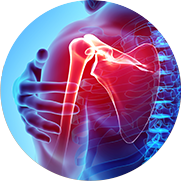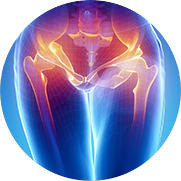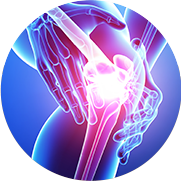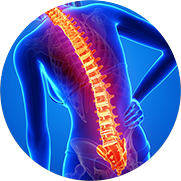Arthritis of the Knee
There are three basic types of arthritis that may affect the knee joint.
Osteoarthritis
Osteoarthritis (OA) is the most common form of knee arthritis. OA is usually a slowly progressive degenerative disease in which the joint cartilage gradually wears away. It most often affects middle-aged and older people.
Rheumatoid Arthritis
Rheumatoid arthritis (RA) is an inflammatory type of arthritis that can destroy the joint cartilage. RA can occur at any age. RA generally affects both knees.
Post-traumatic Arthritis
Post-traumatic arthritis can develop after an injury to the knee. This type of arthritis is similar to osteoarthritis and may develop years after a fracture, ligament injury, or meniscus tear.
|
A healthy knee |
An osteoarthritic knee |
Symptoms
Generally, the pain associated with arthritis develops gradually, although sudden onset is also possible.
The joint may become stiff and swollen, making it difficult to bend or straighten the knee.
Pain and swelling are worse in the morning or after a period of inactivity. Pain may also increase after activities such as walking, stair climbing, or kneeling.
The pain may often cause a feeling of weakness in the knee, resulting in a “locking” or “buckling.”
Many people report that changes in the weather also affect the degree of pain from arthritis.
Doctor Examination
Your doctor will perform a physical examination that focuses on your walk, the range of motion in the limb, and joint swelling or tenderness.
X-rays typically show a loss of joint space in the affected knee.
Blood and other special imaging tests, such as magnetic resonance imaging (MRI) may be needed to diagnose rheumatoid arthritis.
|
Normal joint space between the femur and tibia. |
Decreased joint space due to damaged cartilage and bone spurs. |
Nonsurgical Treatment
If you have osteoarthritis of the knee, you can take advantage of a wide range of treatment options. The effectiveness of different treatments varies from person to person. The choice of treatment should be a joint decision between you and your physician.
The purpose of treatment is to reduce pain, increase function and generally reduce your symptoms. Patient satisfaction is a fundamental goal in treating osteoarthritis of the knee
In its early stages, arthritis of the knee is treated with nonsurgical measures. Nonsurgical treatments fall into four major groups: lifestyle modifications; exercise; supportive devices; other methods.
Lifestyle Modification
Lifestyle modifications can include losing weight, switching from running or jumping exercises to swimming or cycling, and minimizing activities that aggravate the condition, such as climbing stairs. Many, but not all, people with osteoarthritis of the knee are overweight. Simple weight loss can reduce stress on weight bearing joints, such as the knee. Losing weight can result in reduced pain and increased function, particularly in walking.
Exercise
Exercises can help increase range of motion and flexibility as well as help strengthen the muscles in the leg. Physical therapy and exercise are often effective in reducing pain and improving function. Your physician or a physical therapist can help develop an individualized exercise program that meets your needs and lifestyle
Supportive Devices
Using supportive devices, such as a cane, wearing energy-absorbing shoes or inserts, or wearing a brace or knee sleeve can be helpful. Some research studies have focused on the use of knee braces for treatment of osteoarthritis of the knee. They may be especially helpful if the arthritis is centered on one side of the knee. A brace can assist with stability and function. There are two types of braces that are often used. An “unloader” brace shifts load away from the affected portion of the knee. A “support” brace helps support the entire knee load. In most studies, the knee symptoms improved, with a decrease in pain on weightbearing and a general ability to walk longer distances.
Other Methods
Other measures may include applications of heat or ice, water exercises, liniments or elastic bandages.
Drug Treatment
Several types of drugs can be used in treating arthritis of the knee. Because every patient is different, and because not all people respond the same to medications, your orthopaedic surgeon will develop a program for your specific condition.
Anti-inflammatory medications can include aspirin, acetaminophen or ibuprofen to help reduce swelling in the joint. Simple pain relievers such as Tylenol are available without a prescription and can be very effective in reducing pain. Pain relievers are usually the first choice of therapy for osteoarthritis of the knee. All drugs have potential side effects and simple analgesics are no exception. In addition, with time, your body can build up a tolerance, reducing the effects of the pain reliever. It is important to realize that these medications, although purchased over-the-counter, can also interact with other medications you are taking, such as blood-thinners. Be sure to discuss these issues with your orthopaedist or primary physician.
A more potent type of pain reliever is a nonsteroidal anti-inflammatory drug or NSAID. These drugs, which include brands such as Motrin, Advil and Aleve, are available in both over-the-counter and prescription forms. Like all pain relievers, NSAIDs can cause side effects including changes in kidney and liver function as well as a reduction in the ability of blood to clot. These effects are usually reversible when the medication is discontinued.
A COX-2 inhibitor is a special type of NSAID that is often prescribed if knee pain is moderate to severe. Common brand names of COX-2 inhibitors include Celebrex and Vioxx. It should be noted that Vioxx was recently withdrawn from the market by its manufacturer. COX-2 inhibitors reduce pain and inflammation so that you can function better. If you are taking a COX-2 inhibitor, you should not use a traditional NSAID (prescription or over-the-counter). Be sure to tell your doctor if you have had a heart attack, stroke, angina, blood clot or hypertension or if you are sensitive to aspirin, sulfa drugs or other NSAIDs.
COX-2 inhibitors can have side effects, including abdominal pain, nausea and indigestion. Antacids or a fatty meal can limit the body’s ability to absorb and use COX-2 inhibitors, so do not take them together. These drugs are less irritating to the stomach than other NSAIDs, but abdominal bleeding can occur, sometimes without warning.
Glucosamine and Chondroitin
Glucosamine and chondroitin (kon-dro’-i-tin) sulfate are oral supplements may relieve the pain of osteoarthritis. These are two large molecules that are found in the cartilage of our joints. Supplements sold over-the-counter are usually made from synthetic or animal products.
Glucosamine and/or chondroitin sulfate may be particularly helpful in the early stages of osteoarthritis of the knee, provided they are used as directed on package inserts and with caution. Although glucosamine and chondroitin sulfate are natural substances, sometimes classified as food additives, they can cause side effects such as headaches, stomach upset, nausea, vomiting, and skin reactions. These supplements can interact with other medications, so keep your doctor informed about your use of them.
These substances can help reduce swelling and tenderness, as well as improve mobility and function. If you decide to take this therapy, it is important not to discontinue too soon. At least two months of continuous use is necessary before the full effect is realized.
Corticosteroids
Corticosteroids are powerful anti-inflammatory agents that can be injected into the joint.
They are given for moderate to severe pain. They can be very useful if there is significant swelling, but are not very helpful if the arthritis affects the joint mechanics.
Corticosteroids or cortison are natural substances known as hormones. They are produced by the adrenal glands in the human body. They can provide pain relief and reduce inflammation with a subsequent increase in quadriceps (thigh muscle) strength. However, the effects are not long-lasting, and no more than four injections should be given per joint per year.
In addition, there is some concern about the use of these injections. For example, pain and swelling may “flare” immediately after the injection, and the potential exists for long-term joint damage or infection. With frequent repeated injections or over an extended period of time, joint damage can actually increase rather than decrease.
Viscosupplementation with Hyaluronic Acid
Viscosupplementation involves injecting substances into the joint to improve the quality of the joint fluid. Complete coverage of this technique can be found in the article titled “Viscosupplementation Treatment for Arthritis.”
Gold Salt Injections
Special medical treatments for rheumatoid arthritis include gold salt injections and other disease-modifying drugs.
Alternative Therapies
Alternative therapies include the use of acupuncture and magnetic pulse therapy. Many forms of therapy are unproven, but reasonable to try, provided you find a qualified practitioner and keep your physician informed of your decisions.
Acupuncture uses fine needles to stimulate specific body areas to relieve pain or temporarily numb an area. Although it is used in many parts of the world and evidence suggests that it can help ease the pain of arthritis, there are few scientific studies of its effectiveness. Be sure your acupuncturist is certified, and do not hesitate to ask about his or her sterilization practices.
Magnetic pulse therapy is painless and works by applying a pulsed signal to the knee, which is placed in an electromagnetic field. Like many alternative therapies, magnetic pulse therapy has yet to be proven.
Surgical Treatment
If your arthritis does not respond to these nonsurgical treatments, you may need to have surgery.
There are a number of surgical options, including the following:
- Arthroscopic surgery uses fiber optic technology to enable the surgeon to see inside the joint and clean it of debris or repair torn cartilage.
- An osteotomy cuts the shinbone (tibia) or the thighbone (femur) to improve the alignment of the knee joint.
- A total or partial knee arthroplasty replaces the severely damaged knee joint cartilage with metal and plastic.
- Cartilage grafting is possible for some knees with limited or contained cartilage loss from trauma or arthritis.
On the Horizon
Orthopaedic surgeons are continuing to search for new ways to treat arthritis of the knee. Current research is focusing on new drugs as well as on cartilage transplants and other ways to help slow the progress of arthritis.
AAOS does not endorse any treatments, procedures, products, or physicians referenced herein. This information is provided as an educational service and is not intended to serve as medical advice.











